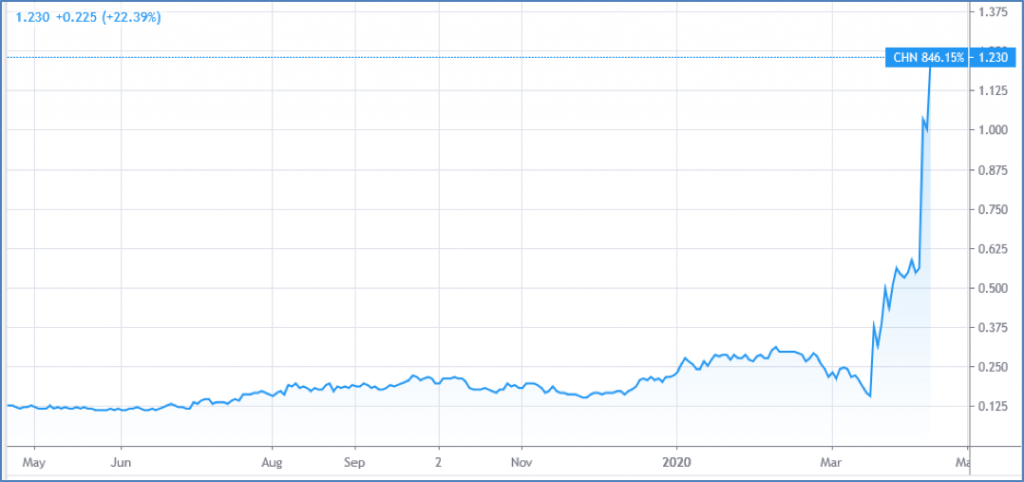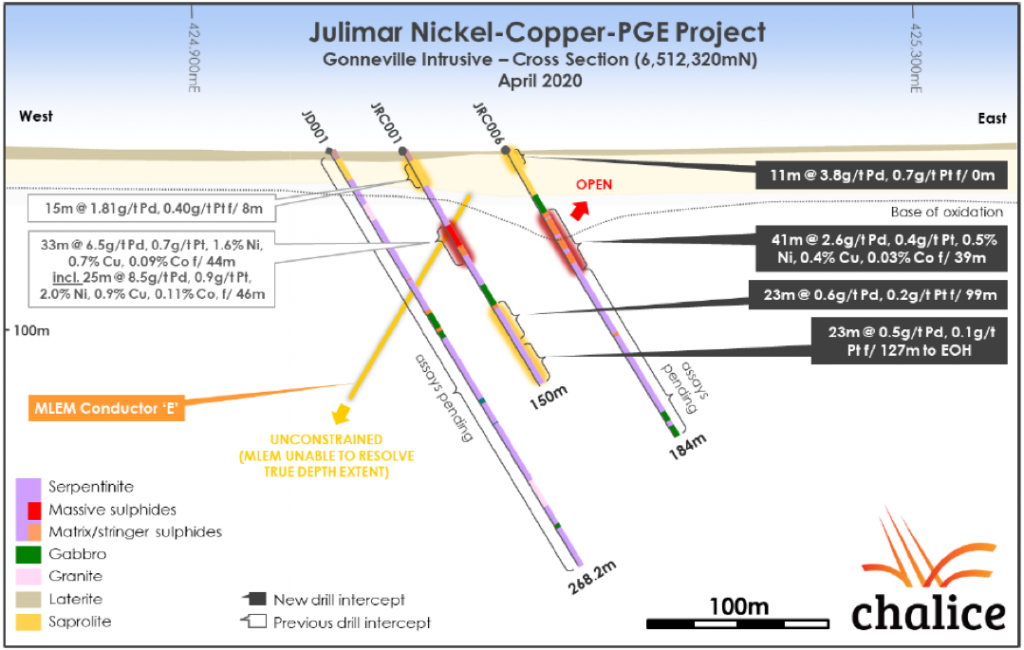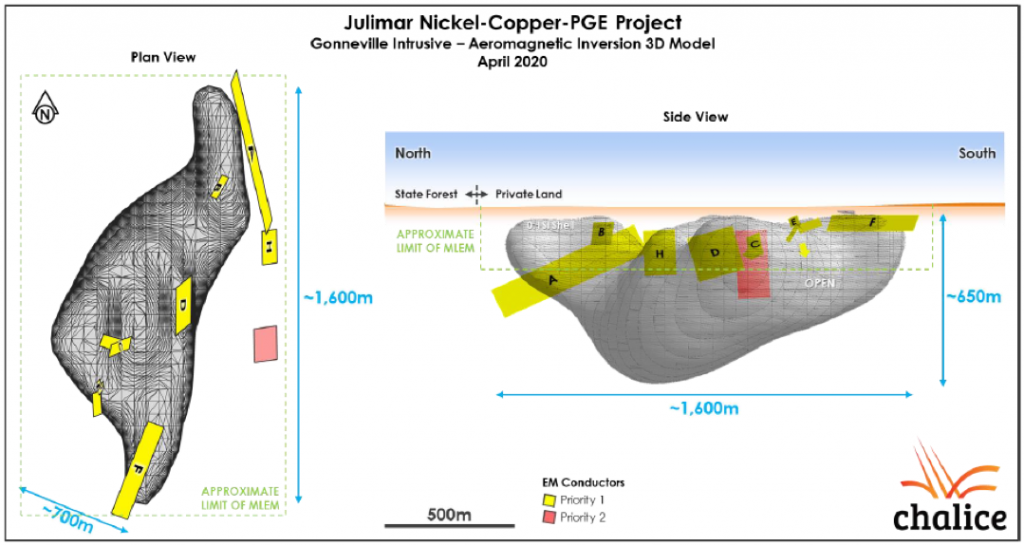Chalice Gold Mines – (ASX: CHN, Share Price: $1.23, Market Cap: $337m, coverage initiated @ $0.16 in March 2019 – current gain of 669%)

Key Catalyst
New wide high-grade palladium-nickel-copper zone intersected at Julimar Project, ~60m east of the discovery hole, together with wide palladium intervals in all six drill holes assayed to date.
We initiated coverage of CHN during March 2019 due to CHN’s involvement in the burgeoning Victorian gold exploration scene. CHN’s primary focus has been its 100%-owned Pyramid Hill Gold Project, a 5,190 sq km district-scale holding within the reinvigorated Bendigo gold district. The region that has produced more than 60M oz of high-grade gold, yet has seen minimal exploration under shallow cover. CHN has actively explored the project since 2018, outlining several large-scale targets from shallow reconnaissance drilling. Since March 2020, the company has enjoyed immediate exploration drilling success at its Julimar nickel sulphide project in Western Australia, where it has outlined an outstanding discovery. CHN importantly is self-funded when it comes to exploration, not having raised capital since 2011, generating net proceeds of >$100m from asset sales, with more than $36mn returned to shareholders since 2012.
Latest Activity
Julimar Project Update
CHN has released further outstanding new drilling results at its 100%-owned Julimar Nickel-Copper-PGE Project, located just ~70km northeast of Perth in Western Australia.
Ongoing RC drilling activity has intersected an exceptional new, wide and high-grade palladium-nickel-copper zone in hole JRC006 from surface, located ~60m east of the discovery hole JRC001. As a reminder, JRC001 generated an outstanding intercept of 19m @ 8.4g/t Pd, 1.1g/t Pt, 2.6% Ni, 1.0% Cu and 0.14% Co from 48m.
This new mineralised zone encountered in hole JRC006 has so far identified mineralisation within two separate primary zones, with outstanding assay results received so far for the first 80m only:
– From surface to 29m depth is the first intercept, comprising 29m @ 1.9g/t Pd and 0.4g/t Pt from surface (oxide), including 11m @ 3.8g/t Pd and 0.7g/t Pt.
– From 39m to 80m depth is the second intercept, comprising 41m @ 2.6g/t Pd, 0.4g/t Pt, 0.5% Ni, 0.4% Cu and 0.03% Co, including 31m @ 3.3g/t Pd, 0.5g/t Pt, 0.7% Ni, 0.5% Cu and 0.04% Co from 40m.

Encouragingly, all of the six RC drill holes assayed to this point have intersected broad zones of significant palladium mineralisation with associated base metals, with three of these RC holes ending in mineralisation and thus helping confirm the large-scale potential of the Gonneville Intrusive.
The Gonneville Intrusive has been modelled by CHN as a ~1.6km long x ~0.7km wide chonolith (irregularly-shaped intrusive body), which possesses favourable geometry similar to large-scale magmatic sulphide deposits globally – including Jinchuan in China and Kabanga in Tanzania.
The new zones are interpreted to be striking parallel to the zone in JRC001 and remain open in all directions, which aligns them with an early to mid-time MLEM anomaly located ~200m to the south.

Figure 2: The Gonneville Intrusive – Aeromagnetic Inversion 3D Model and modelled EM conductors.
Technical Significance
The Julimar drilling points almost certainly to a very large palladium-nickel discovery, with associated platinum, copper and cobalt. All of the drill-holes have intersected significant broad zones of palladium that highlights the metal-rich nature of the intrusive and its potential to deliver a discovery of considerable scale. The latest drilling results have also identified what appears to be a new parallel high-grade Pd-Ni-Cu zone to the east of the initial discovery intercept, which remains wide open and appears to have significant strike potential.
The interpreted chonolith geometry is considered significant, as similar irregular intrusive bodies host globally significant magmatic Ni-Cu+/-PGE sulphide deposits including Jinchuan in China and Kabanga in Tanzania. While the broad palladium intervals point to a large-scale PGE discovery, the company’s focus is on defining higher-grade zones of mineralisation which, according to the geological analogues such as Jinchuan in China and Kabanga in Tanzania, could be found at depth below the disseminated sulphide zones. As such, two rigs continue to drill high-priority EM targets that are being generated with DHEM.
From a broader perspective, the Julimar discovery has shown the region to be a new Ni-Cu-PGE province, so regional activities are also now being planned.
Next Steps
The RC rig will continue to test new targets defined with DHEM, as well as step-out around known zones of mineralisation. A review of EM modelling techniques is underway to maximise the effectiveness of DHEM and to ensure modelling of conductive responses is verified. DHEM will continue to be critical in identifying potential targets for follow-up drilling and will be completed on all holes.
Soil sampling over the Gonneville Intrusive, including PGEs that were not covered with the existing pXRF soil sampling data, will commence shortly. A high-resolution ground gravity survey is also underway.
Preparations are underway to gain access to the State Forest-covered areas of the Julimar Intrusive Complex, to the north of the Gonneville Intrusive. The approval process is anticipated to take 4-6 months and will be progressed in parallel to activities at Gonneville.
CHN has applied for +2,300 sq km of new exploration licences in the region to expand its strategic footprint in this potential new nickel-copper-PGE province. Targets are also being evaluated on its Barrabarra Nickel Project, located ~250km north of Julimar, which also hosts an interpreted intrusion complex in a similar geological setting, near the western margin of the Yilgarn craton.
Summary
CHN’s share price has surged from a 12-month low of $0.125 to a current price of $1.23. Its share price surge has seen it firm strongly since our coverage initiation in March 2019 at a price around $0.16.
The results from Julimar are particularly significant because they involve the first-ever drilling undertaken at the project. Even at this very early stage of exploration, the discovery of a shallow high-grade massive sulphide zones within a large layered ultramafic-mafic intrusion is very exciting, as it draws potential parallels with other large-scale nickel-copper-PGE sulphide discoveries worldwide.
Just as importantly, CHN is cashed-up and so unlike the majority of its exploration peers it doesn’t have to concern itself with trying to raise exploration funds in somewhat difficult market conditions. We await further results with great interest.




